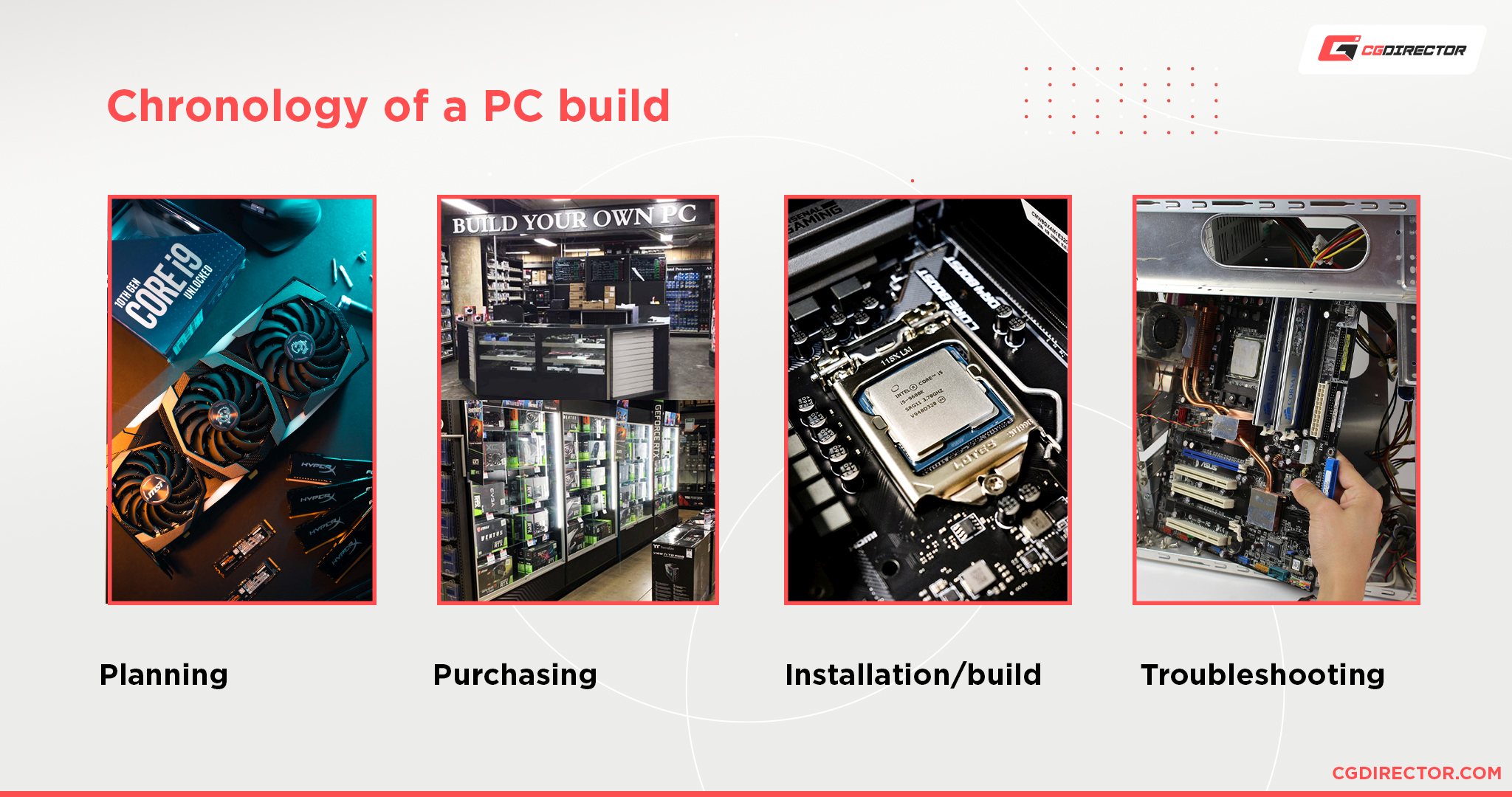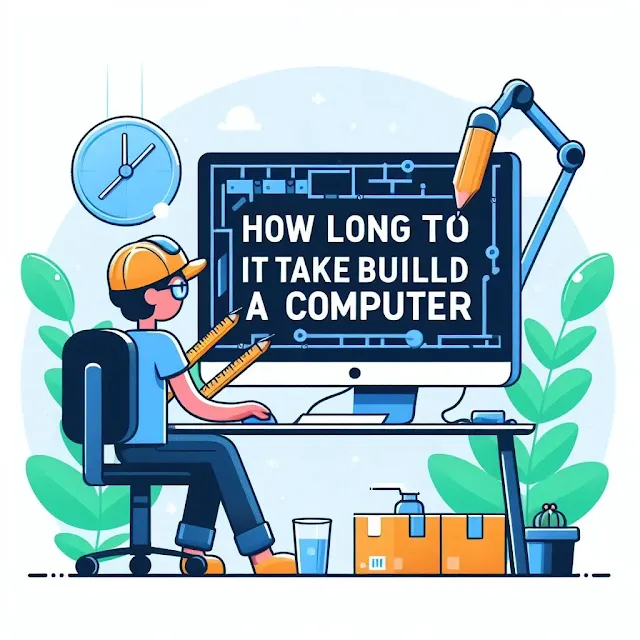How Long Does It Take to Build a Computer
Building a computer can typically take a few hours to a day, depending on your experience and the complexity of the build. From selecting the components to assembling them and installing the operating system, the process can range from 2 to 8 hours for most people.
While it may seem daunting at first, with the right guidance and patience, anyone can successfully build their own computer. We will explore the process of building a computer, the time it takes, and some tips for a smooth and successful build. So, let's dive in and discover the ins and outs of building a computer!

Credit: www.reddit.com
Factors Affecting Build Time
Factors affecting build time in computer assembly include components selection and level of experience.
Component Selection
Each component type affects build time differently. For instance, installing an SSD is quicker than setting up liquid cooling.
Experience Level
Novices may take longer due to learning curves compared to seasoned builders who work more efficiently.
Preparation Phase
The preparation phase is a crucial step when it comes to building a computer. It involves researching components and gathering tools that are needed for the assembly process. By taking the time to properly prepare, you can ensure that everything runs smoothly and efficiently.
Researching Components
Prior to starting the build, it's important to research the components you'll need for your computer. This includes the CPU, motherboard, RAM, storage devices, and graphics card. Each component choice will depend on your specific needs and budget.
By researching the different options available, you can make informed decisions about which components will work best for your desired performance and functionality. Consider factors such as compatibility, performance benchmarks, and user reviews to help guide your selection process.
Gathering Tools
Once you have determined the components for your build, it's time to gather the necessary tools. Having the right tools on hand will help make the assembly process much smoother and more efficient. Here is a list of essential tools you may need:
- Screwdriver set: To securely fasten the components in place.
- Thermal paste: To ensure proper heat transfer between the CPU and cooling system.
- Cable management tools: To neatly organize the cables inside the case.
- Anti-static wrist strap: To protect the components from static electricity.
- Wire cutters or scissors: To trim cable ties or cut wires as needed.
Gathering these tools beforehand will save you time and prevent unnecessary delays during the assembly process. It's important to have everything easily accessible and organized so that you can work efficiently.
Assembly Process
When building a computer, the assembly process is a crucial step that determines the overall performance and functionality of the system. Assembling a computer involves installing various components and ensuring proper cable management to optimize airflow and maintain a clean interior. Let's delve into the assembly process, focusing on Installing Components and Cable Management.
Installing Components
Installing components is a fundamental aspect of building a computer. This process involves mounting the motherboard, CPU, RAM, graphics card, storage drives, and power supply unit into the computer case.
Each component necessitates careful handling to prevent static discharge and physical damage. The installation process demands precision and attention to detail to ensure that the components fit snugly and securely within the case.
Cable Management
Cable management is essential for maintaining a tidy and organized interior of the computer case. Proper cable management not only enhances aesthetics but also promotes better airflow, which is critical for cooling components and preventing overheating.
It involves the strategic routing and bundling of cables to minimize clutter and obstruction within the case. Effective cable management facilitates easier maintenance and upgrades in the future, as well as improves overall system performance.

Credit: www.cgdirector.com
Testing And Troubleshooting
When it comes to building a computer, the process of testing and troubleshooting is crucial to ensure that all the components are functioning properly and the system is ready for use. Testing involves checking the hardware and software components, while troubleshooting is the process of identifying and resolving any issues that may arise during or after the build.
Boot-up Testing
Boot-up testing is the initial step in ensuring the functionality of the newly built computer. This involves powering up the system and checking for any error messages, unusual noises, or abnormal behavior during the boot-up process.
Diagnostic Checks
Diagnostic checks are essential for identifying any potential hardware or software issues. This includes running diagnostic software to test the performance of individual components such as the CPU, RAM, graphics card, and storage drives. It also involves checking for compatibility issues and ensuring that all drivers are installed and up to date.
Customization Options
When it comes to building a computer, one of the best aspects is the opportunity for customization. Customization options allow you to tailor the computer to meet your specific needs and preferences.
Whether you want a sleek and minimalistic design or a flashy and vibrant one, there are several customization options to consider. In this article, we will explore the different customization options available when building a computer, including RGB lighting and overclocking.
Rgb Lighting
RGB lighting has become increasingly popular among computer enthusiasts. With RGB, or Red-Green-Blue, lighting, you can create stunning and vibrant lighting effects for your computer. RGB components, such as fans, keyboards, and RAM modules, feature customizable lighting options that allow you to choose from a wide range of colors and lighting patterns.
Whether you prefer a subtle and elegant look or a bold and eye-catching one, RGB lighting can add a touch of personalization to your computer.
Overclocking
Overclocking is a technique used to increase the performance of your computer's components beyond their factory settings. By adjusting the clock speeds and voltages of the CPU, GPU, and RAM, you can achieve higher processing power and faster speeds.
Overclocking is particularly popular among gamers and content creators who require a powerful and responsive system. However, it's important to note that overclocking may increase the heat and power consumption of your computer, so proper cooling and a stable power supply are essential.

Credit: www.youtube.com
Time Estimates
Building a computer can take anywhere from a few hours to a day, depending on your experience and the complexity of the build. Factors such as custom water cooling, cable management, and software installation can also impact the time it takes to complete the build.
Time Estimates
Beginner Builders
For individuals new to building computers, it can take about 2 to 3 hours to assemble all the components.
Experienced Builders
Those with previous experience typically complete building a computer in around 1 to 2 hours.
Resource Utilization
Building a computer involves careful resource utilization in order to optimize its performance. The time it takes to complete this process may vary depending on the complexity of the system and the expertise of the builder.
Online Guides
Online guides provide step-by-step instructions for building a computer independently.
Tech Support
Tech support services offer assistance in troubleshooting and resolving any issues during the assembly process.
Realistic Expectations
When it comes to building a computer, it's important to have realistic expectations about the time it will take to complete the process. Understanding the factors that can affect the timeline will help you plan accordingly and avoid frustrations along the way.
Patience Is Key
Building a computer requires patience. It is not a task that can be rushed if you want to ensure a successful outcome. From researching and purchasing the components to assembling and testing, each step takes time.
It's important to remember that building a computer is a meticulous process that requires attention to detail. Rushing through the steps can lead to mistakes that can affect the overall performance and functionality of your system.
Investing time in understanding the components and their compatibility is crucial. This includes selecting the right processor, motherboard, memory, storage, and graphics card. Taking the time to research and make informed decisions will help you avoid compatibility issues or the need to make returns or exchanges.
Once you have gathered all the components, the actual assembly process begins. This involves carefully installing each part into the case, connecting cables, and ensuring everything is secure and properly positioned.
Unexpected Delays
Despite careful planning and preparation, unexpected delays can occur during the computer-building process. These delays may include:
| Delays | Possible Causes |
|---|---|
| Shipping delays | Problems with courier services or unforeseen circumstances |
| Compatibility issues | Unforeseen conflicts between components |
| Technical difficulties | Software installation or configuration issues |
It's important to be prepared for these delays and have a backup plan in place. You may need to wait for a replacement part, troubleshoot compatibility issues, or seek support for technical difficulties.
By acknowledging that unexpected delays can happen, you can manage your expectations and avoid unnecessary frustrations.
In conclusion, building a computer requires patience and realistic expectations. It is a process that cannot be rushed if you want to ensure a well-functioning system. Being prepared for potential delays and investing time in research and careful assembly will lead to a successful outcome.
Frequently Asked Questions Of How Long Does It Take To Build A Computer
How Long Does It Typically Take To Build A Computer?
Building a computer usually takes around 2-3 hours for beginners and 1-2 hours for experienced individuals.
What Factors Can Affect The Time It Takes To Build A Computer?
The time to build a computer can be influenced by the complexity of the build, component compatibility, and prior experience.
Are There Any Specific Tools Required To Build A Computer?
Basic tools such as screwdrivers, thermal paste, and an anti-static wrist strap are commonly used when assembling a computer.
Does Building A Computer Require Technical Expertise?
While technical expertise is beneficial, many resources and tutorials are available to guide beginners through the process of computer assembly.
Can Building A Computer Save Money Compared To Buying A Pre-built One?
Yes, building a computer can often be more cost-effective as it allows for customization and potentially lower overall costs compared to pre-built options.
Conclusion
To summarize, building a computer requires careful consideration, time, and effort. From selecting the right components to assembling them correctly, the process can take anywhere from a few hours to a few days, depending on your experience and the complexity of the build.
It is crucial to have a clear plan and gather all the necessary tools before beginning the process. By following the steps outlined you can ensure a successful and efficient build. Happy building!






